Warming Up Is Always a Good Idea—but It's a Must During the Winter
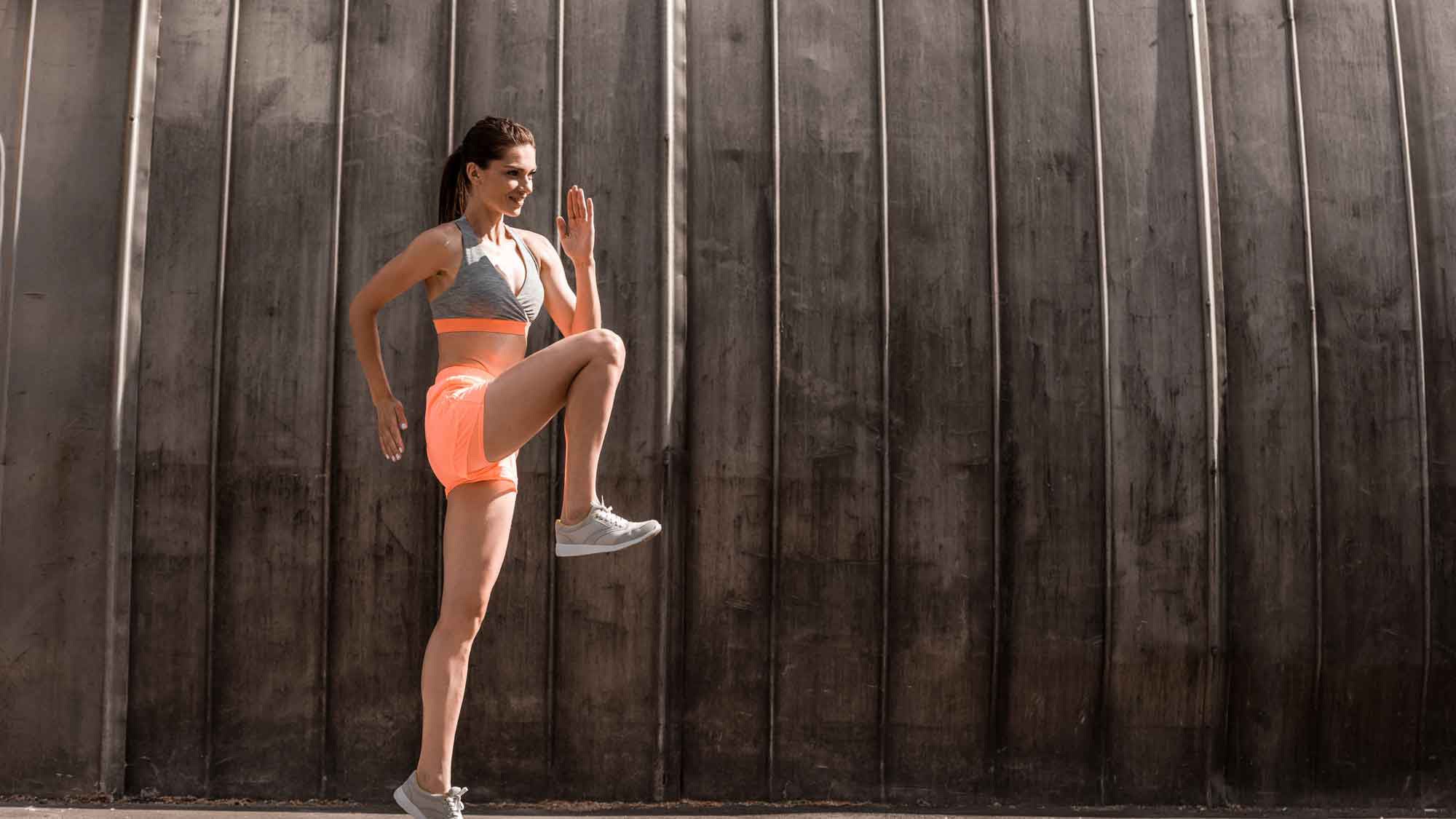
Baby, it’s cold outside, and you’re ready to put on your highest tech thermal gear and get out there already. Wait a sec—you’re almost ready. Doing a warm-up is smart any time of year, but it’s especially important when the mercury drops. A few minutes spent prepping for your run could help you perform better and reduce your risk of injuries.
When winter’s going full force and you’re out in it, your body wants to keep your vital organs warm, so it cuts back on circulation to your extremities—though helpful for your life, this isn’t 100 percent great for your running because your extremities are where most repetitive stress injuries occur, says Andrea Fradkin, Ph.D., associate professor in the department of exercise science at Bloomsburg University, who has done numerous research studies on warm-ups and injury prevention. Chilly air also reduces muscle-contraction force, which means that during hard efforts, your tendons and ligaments receive more stress at a time when they’re already a little vulnerable due to that lower blood supply.
Fortunately, Fradkin says that a good warm-up prepares your body for your run and helps you reduce these cold-related risks.
So what exactly is a good warm-up?
It has three parts (don’t worry; they’re quick).
1. Increase the temperature of your body.
Any kind of aerobic activity will raise your heart and breathing rates, Fradkin says. But as a runner, you might as well make this time work for your sport, so it’s a perfect opportunity to do all those drills you keep meaning to add to your workouts, like butt kicks, high knees, skipping and carioca (grapevine crossovers). See Know the Drill below for bonus tips.
2. Stretch, if you need it.
If there are spots you need to stretch because they tend to get injured, do it now. Stretching before you run is controversial, but not to Fradkin, who cites this evidence: “My research has shown that as long as the body is warm prior to doing it, then there is no performance decrement to doing any type of stretching.”
3. Finally, work into your run.
Start slowly and build up to the pace(s) your workout is designed to hit that day. This is the equivalent of golfers or tennis players doing air swings before they hit a ball—it rehearses what you’re about to do. That enhances neuromuscular coordination, and it prepares your mind for what’s to come as well, Fradkin says.
How long does all this take?
It doesn’t have to take forever—even a little less than 10 minutes should be enough on most days. “My research has found that you really don’t need to warm up for extended periods of time, and in many cases, undertaking a long warm-up can start to use up some of your energy and negatively affect your performance,” Fradkin says. In the lab, scientists know that you’re warmed up by measuring core body temperature. “But considering that’s not a viable option for most people, the general rules of thumb include seeing a very light sweat and having an increased breathing and heart rate to the point where you can still speak a sentence without gasping for air, but nowhere near as well as when you are just resting,” she says.
On super-cold days, do a little more: An often-quoted rule of thumb is that for every 10-degree drop below 30 degrees F, you should extend your warm-up by five minutes. If you’re warming up indoors first, though, make sure you go out with dry clothes on. You don’t want to start clammy and get even colder.
High Knees
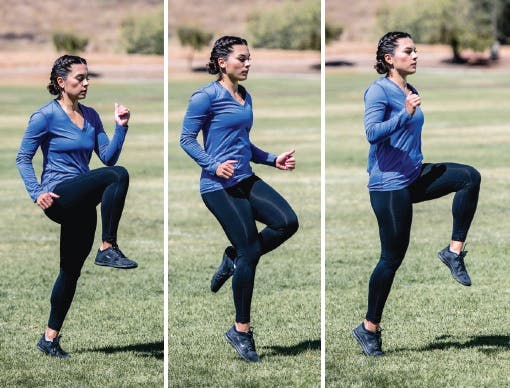
Move forward while lifting your knees in front of you; your thighs will be parallel to the ground. Don’t lean back; just let your knees do the work. You won’t move forward very quickly on these, and that’s one way to know you’re doing them right. This helps teach you to avoid a plodding stride, and it strengthens your hip flexors and quads, too.
Butt Kicks
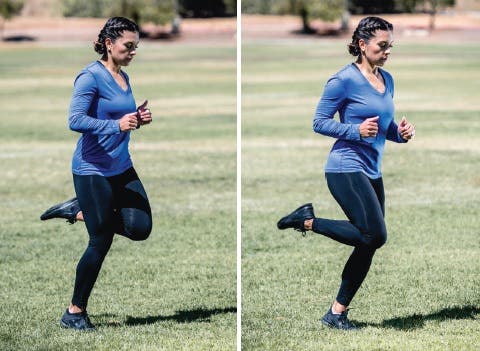
Keeping your thighs almost straight up and down, let your heel come up and “kick” as close to your butt as you can. You’ll move forward as you do these, but focus more on kicking back quickly than on moving forward. This is great for strengthening your hamstrings and helping speed up your turnover.
Skipping
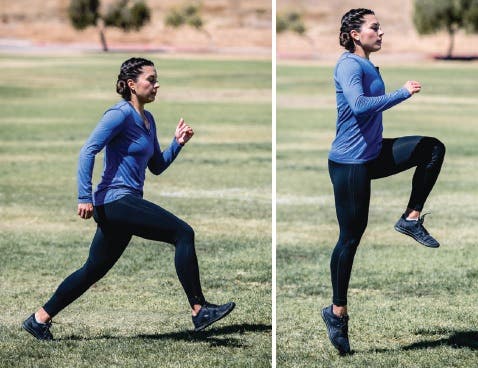
These are just like what you did in grade school, except the game here is to go high, not far. Practice these for a stronger push-off, to help train the shuffle out of yourself and to put a more powerful knee lift into your form.
Carioca
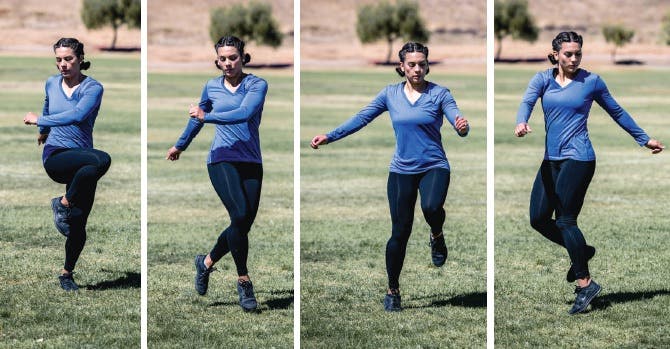
Remember the “grapevine” step in aerobics? This is that, except you do it in one direction for about 20 yards before turning around and moving in the other direction. Skipped the aerobics craze (or did it skip you)? Here’s the 101: Simply step your right foot out to your right side and let it take your weight. Cross your left foot in front of it, then step your right foot out to your right side again. Then cross your left foot behind you. Keep alternating for about 20 yards. It’s great for your range of motion and for building agility.
Behind The Scenes Of Your Warm-Up
You might just notice that it’s easier to move and that your heart and breathing rates are elevated. But a whole host of amazing things goes on inside your body once you get moving. Among them:
- When your muscles get warm, they contract and relax faster. There’s less viscous resistance in them, so you’ll move more efficiently—and you can produce more power.
- You enhance certain chemical responses that improve energy production and lessen fatigue.
- Your muscles and ligaments are better able to absorb the forces of running.
And that’s just a few of the things a short warm-up can do—and why you want to keep it in your routine even when summer rolls around again.